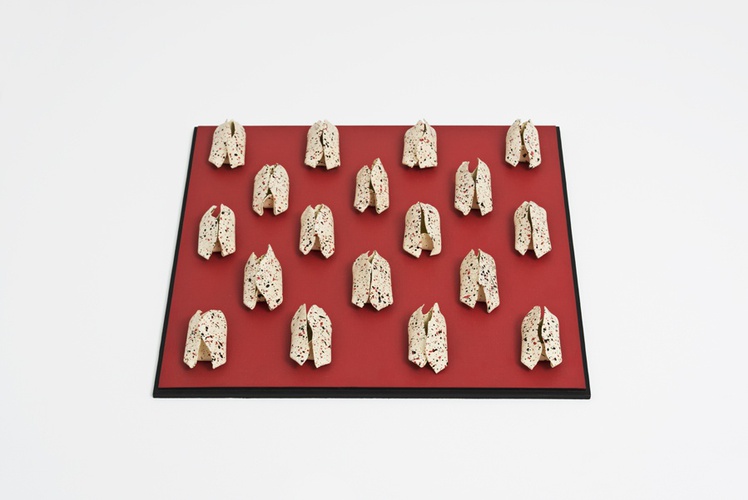“My folded clay pieces are like little pieces of nature, a new species. They exist the way sea shells exist…” – Hannah Wilke
This is Alison Jacques fourth solo exhibition of the late American artist Hannah Wilke (1940 – 1993). For this show (London, April 42-May 29), the focus is on Wilke’s sculpture from her early terracotta works of the ‘60s through to the more richly coloured installations of the ‘80s. It also encompasses the theme of her body as sculpture seen in performative photographs as well as drawings from the ‘60s and ‘70s which either refer to her sculptures or demonstrate a visceral physicality that feels completely in dialogue with her sculptural practice.
The gallery worked in partnership with The Hannah Wilke Collection & Archive, Los Angeles to assemble a succinct survey of iconic and lesser-known works which shed light on Wilke’s sculptural vocabulary. One of her earliest and most important sculptures That Fills Earth, (1965) is an earthy terracotta cube opening into organic forms. By pairing this explicit symbol of Modernism: the cube, with quasi-Metaphysical essentialism, Wilke demonstrates an idea of the “Modern Woman” – deconstructing a complicated living being into an ostensibly simplistic material form.
The show continues with a survey of sculptures that have been widely identified by scholars but rarely seen in public including her Generation Process Series grid groups from the mid-1980s. In each of the latter, Wilke placed hand-painted ceramic sculptures in geometric arrangements across painted boards, employing colour, pattern and her signature folded-gesture forms to both acknowledge and subvert her male contemporaries’ obsession with the mathematics of grid systems.
The main focus of the show is Wilke’s choice of materials and what they represent. In the exhibition catalogue to accompany Gestures, the most comprehensive survey of Wilke sculpture to date (Neuberger Museum, New York, 2008), the curator Tracy Fitzpatrick states:
“Wilke’s practice is rooted in her devotion to malleability and her interest in vulnerability. Throughout her career she created art from unusual materials, plastic and fragile in composition, and then placed these objects in compromising situations – hinged with pins or glued to walls and boards, placed freely on the floor, always seemingly on the verge of disaster, always questioning: Will it fall? Will it crack? This vulnerability, so much a part of Wilke’s work, is also carefully constructed strategy, perilous but orchestrated by the artist. The combination of these seemingly opposing forces creates a unique tension throughout her artistic production.”
An area of Wilke’s work, which is shown here in depth, are the kneaded erasers series from the 1970s, in which Wilke used simple everyday grey colour erasers and adapted this material into an entire series of work. Wilke placed her kneaded erasers, moulded into little gestural folded forms, onto various surfaces including boards on plinths but also everyday utensils such as Fork and Spoon (1974) and vintage postcards including Sea Wall (1975), and The Beach, The Pines, Cotuits, Mass (1977). Other materials including Wilke’s signature chewing gum are present in the show, from photographs which make up the iconic SOS series to her lesser known large-scale photographic work called California Series where Wilke photographed her gum sculptures outdoors attached to foliage and flowers.
Earlier this year, The Guardian newspaper described Hannah Wilke as “one of the most subversive women artists in history.” Throughout this exhibition, in whatever medium her sculptural forms reside, we are constantly reminded that Wilke saw no contradiction between creating pioneering, confrontational works that helped redefine the extent of feminist activism, whilst creating aesthetically pleasing forms. Wilke was an unapologetic aesthete, stating in an interview with Lil Picard in 1973: “The concept of the disagreeable object had offended me, and I decided to make ‘agreeable objects.’ I don’t feel happy on any level with disagreeable forms – I love beautiful things.”

Hannah Wilke, That Fills Earth, 1965, terracotta, 9 1/2″ x 8 1/2″ x 8 1/2″

Hannah Wilke, Utitled, c. 1970s, watercolor on paper, 22″ x 30″ unframed

Hannah Wilke, Fork and Spoon, 1974, kneaded erasers on metal utensils

Hannah Wilke, Sweet Sixteen, 1977, painted ceramics, 4″ x 32″ x 32″ (board)
Hannah Wilke, Untitled, 1977, porcelain ceramics, 2 3/4″ x 17 1/2″ x 15 1/2″ (board)

Hannah Wilke, Needed-Erase-Her, 1974, kneaded erasers, 2″ x 13 1/2″ x 13 1/2″
Hannah Wilke, Support, Foundation, Comfort, 1984, painted ceramics, 24″ x 18″ (board)

Hannah Wilke, S.O.S. Starification Object Series, 1974, black and white photograph, 7″ x 5″ (unframed)
Hannah Wilke, S.O.S. Starification Object Series, 1974, silver gelatin print, 7″ x 5″ (unframed)

Hannah Wilke, Untitled (Single Gum Sculpture), 1976, gum in plexiglass box, 2 1/2″ x 2 1/2″ x 1″
Hannah Wilke, Untitled (Single Gum Sculpture), 1984, gum in plexiglass box, 2 1/2″ x 2 1/2/” x 1″

Hannah Wilke, Untitled (Single Gum Sculpture), c. 1975, gum in plexiglass box, 2 1/2″ x 2 1/2″ x 1″
Hannah Wilke, Foraminifer, 1961-63, terracotta, 6″ x 6″ x 3″

Hannah Wilke, Generation Process Series #3, c. 1980’s, painted ceramics on painted board, 2 3/4″ x 4″ x 2 1/4″ (each), 3″ x 19″ x 19″ (board)

Hannah Wilke, Generation Process Series #15, c. 1980’s, 2″ x 3 1/2″ x 2″ (each), 3″ x 19″ x 19″ (board)
Visit the Alison Jacques Gallery

Hi there I am so grateful I found your webpage, I really found you
by error, while I was searching on Yahoo for something else, Anyways I
am here now and would just like to say thanks for a marvelous post and a all round thrilling blog (I also love the theme/design), I
don’t have time to read through it all at the moment but I
have bookmarked it and also added in your RSS feeds,
so when I have time I will be back to read
a lot more, Please do keep up the fantastic jo.
My web blog: facegudef6.com